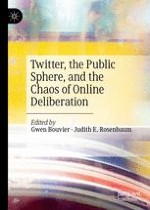2020 | OriginalPaper | Chapter
10. Bros Before Donald Trump: Resisting and Replicating Hegemonic Ideologies in the #BROTUS Memes After the 2016 Election
Authors : Roberta Chevrette, Christopher M. Duerringer
Published in: Twitter, the Public Sphere, and the Chaos of Online Deliberation
Publisher: Springer International Publishing
Activate our intelligent search to find suitable subject content or patents.
Select sections of text to find matching patents with Artificial Intelligence. powered by
Select sections of text to find additional relevant content using AI-assisted search. powered by
